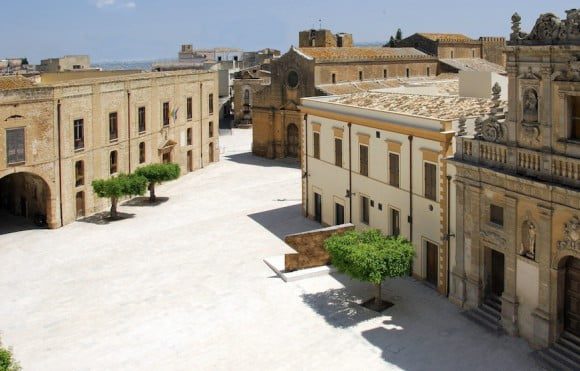Chiesa Madre
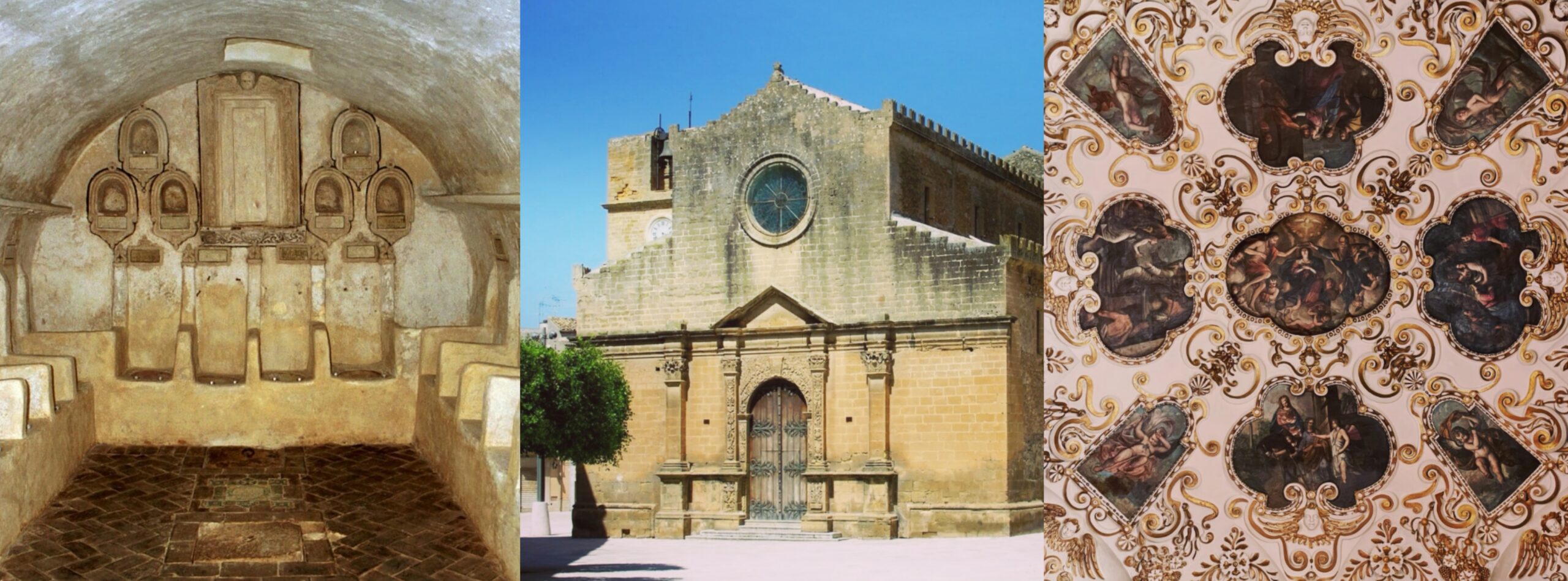
Dedicata a Maria SS. dell’Assunta, sorge dall’unione delle chiese Santa Maria, Santa Chiara e San Giorgio, assumendo tra il 1520 e il 1579 l’aspetto basilicale a croce latina, con 3 navate e copertura a capriate. Alla semplicità dell’esterno con bel portale in stile medievale, si contrappone il ricco interno decorato da stucchi di Antonino Ferraro e Gaspare Serpotta. Custodisce all’interno una statua della Madonna dei Miracoli opera di Massa, la quattrocentesca tavola della Madonna della Misericordia, attribuita alla bottega di Riccardo Quartararo e diverse statue. Interessante è la visita alle cripte.

Dedicated to Our Lady of the Assumption, it rose from the union of the churches of Santa Maria, Santa Chiara and San Giorgio, assuming between 1520 and 1579 the basilica-like appearance of a latin cross, with three naves and a trussed roof. The simplicity of the exterior with its beautiful medieval-style portal contrasts with the rich interior decorated with stucco work by Antonino Ferraro and Gaspare Serpotta. The interior houses a statue of the Madonna of Miracles by Massa, the 15th-century panel of the Madonna of Mercy, attributed to the workshop of Riccardo Quartararo, and several statues. A visit to the crypts is interesting.

Dédiée à Notre-Dame de l’Assomption, elle est née de l’union des églises Santa Maria, Santa Chiara et San Giorgio, prenant entre 1520 et 1579 l’aspect basilical d’une croix latine, avec trois nefs et un toit en treillis. La simplicité de l’extérieur, avec son beau portail de style médiéval, contraste avec la richesse de l’intérieur décoré de stucs réalisés par Antonino Ferraro et Gaspare Serpotta. L’intérieur abrite une statue de la Vierge des Miracles de Massa, le panneau de la Vierge de la Miséricorde du XVe siècle, attribué à l’atelier de Riccardo Quartararo, et plusieurs statues. La visite des cryptes est intéressante.

Sie ist Unserer Lieben Frau von der Himmelfahrt gewidmet und entstand aus der Vereinigung der Kirchen Santa Maria, Santa Chiara und San Giorgio. Zwischen 1520 und 1579 erhielt sie das basilikale Aussehen eines lateinischen Kreuzes mit drei Schiffen und einem Fachwerkdach. Die Schlichtheit des Äußeren mit dem schönen Portal im mittelalterlichen Stil steht im Kontrast zum reichen Innenraum, der mit Stuckarbeiten von Antonino Ferraro und Gaspare Serpotta verziert ist. Das Innere beherbergt eine Statue der Madonna der Wunder von Massa, die aus dem 15. Jahrhundert stammende Tafel der Madonna der Barmherzigkeit, die der Werkstatt von Riccardo Quartararo zugeschrieben wird, und mehrere Statuen. Interessant ist auch ein Besuch der Krypten.
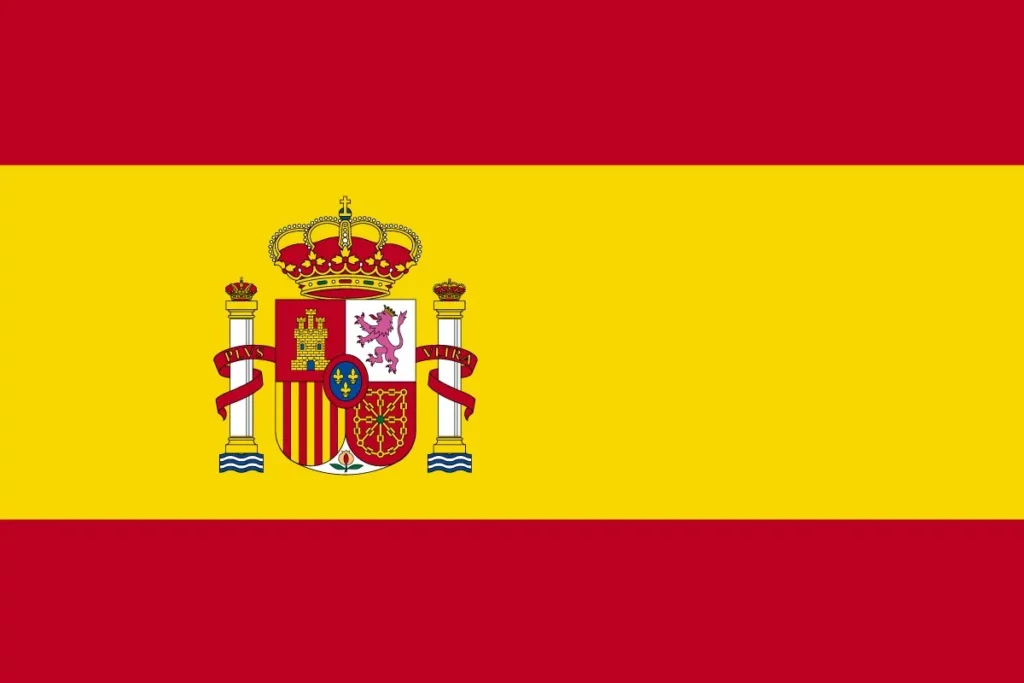
Dedicada a Nuestra Señora de la Asunción, surgió de la unión de las iglesias de Santa Maria, Santa Chiara y San Giorgio, asumiendo entre 1520 y 1579 el aspecto basilical de cruz latina, con tres naves y tejado de cerchas. La sencillez del exterior, con su hermoso portal de estilo medieval, contrasta con el rico interior decorado con estucos de Antonino Ferraro y Gaspare Serpotta. El interior alberga una estatua de la Virgen de los Milagros de Massa, la tabla del siglo XV de la Virgen de la Misericordia, atribuida al taller de Riccardo Quartararo, y varias estatuas. Es interesante visitar las criptas.

تم تكريسها لسيدة العذراء مريم العذراء، وقد نشأت من اتحاد كنائس سانتا ماريا وسانتا كيارا وسان جورجيو، واتخذت بين عامي 1520 و1579 شكل صليب لاتيني يشبه البازيليكا، مع ثلاث بلاطات وسقف ذي دعامات. تتناقض بساطة المظهر الخارجي مع بوابته الجميلة ذات الطراز الذي يعود إلى القرون الوسطى مع التصميم الداخلي الغني المزين بأعمال الجص من تصميم أنتونينو فيرارو وغاسباري سيربوتا. يضم الجزء الداخلي تمثالًا لمادونا المعجزات لماسا، ولوحة مادونا الرحمة التي تعود للقرن الخامس عشر، والتي تُنسب إلى ورشة ريكاردو كوارتارارو، والعديد من التماثيل. زيارة السراديب مثيرة للاهتمام.

这座教堂供奉圣母升天,由圣玛丽亚教堂、圣基亚拉教堂和圣乔治教堂合并而成,在 1520 年至 1579 年间形成了类似拉丁十字架的大教堂外观,拥有三个中殿和一个桁架屋顶。简洁的外观和美丽的中世纪风格的入口,与安东尼诺-费拉罗(Antonino Ferraro)和加斯帕雷-塞尔波塔(Gaspare Serpotta)粉刷装饰的丰富内部形成鲜明对比。内部陈列着马萨(Massa)创作的奇迹圣母雕像、里卡多-夸塔拉罗(Riccardo Quartararo)工作室创作的 15 世纪仁慈圣母画板以及几尊雕像。参观墓室也很有趣。
La Fontana della Ninfa
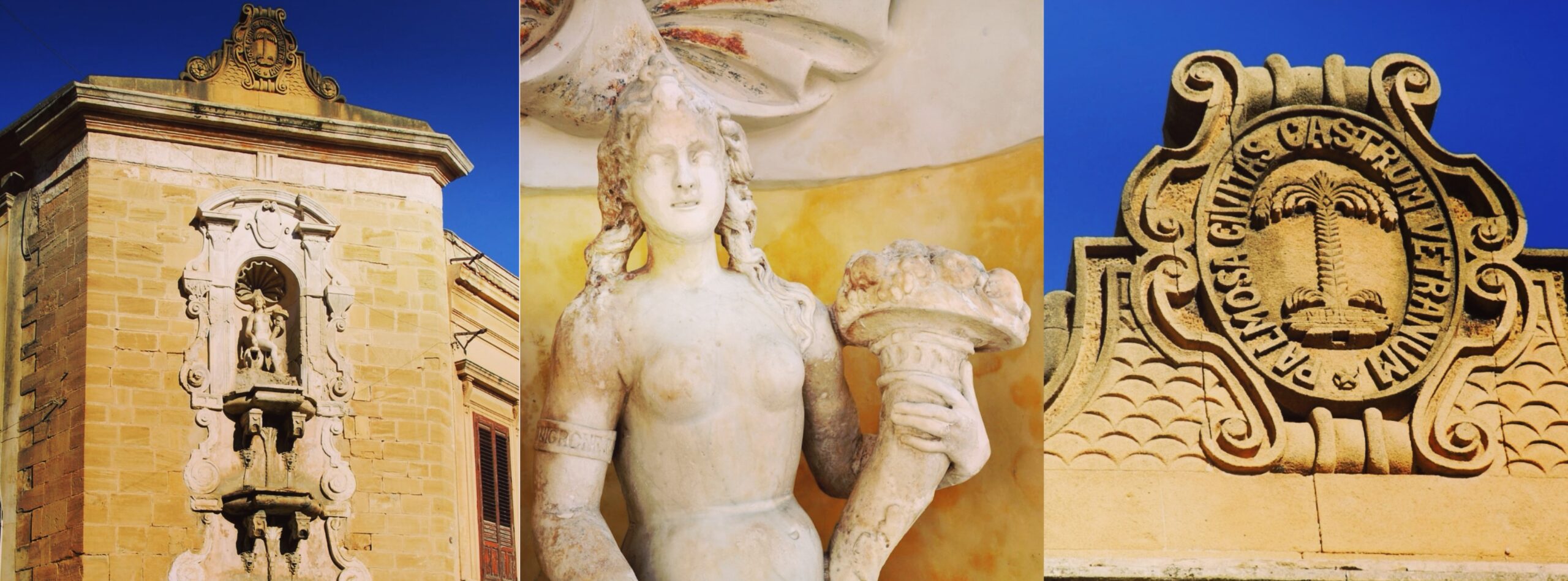
Raro esempio di fontana a sviluppo verticale con 4 vasche sovrapposte e nicchia superiore contenente la statua della Ninfa, progettata da Orazio Nigrone (1615). Orgoglio e vanto dei castelvetranesi, essa ricorda il completamento dell’acquedotto Bigini, un grande traguardo ottenuto dalla città per l’approvvigionamento idrico. In essa è riprodotta più volte la palma, simbolo dei Tagliavia. Oggi la palma è l’emblema della città, assieme alla legenda Palmosa Civitas Castrum Veteranum, con chiara allusione a Selinunte definita Palmosa nel terzo canto dell’Eneide.

A rare example of a vertical fountain with four superimposed basins and an upper niche containing a statue of the Nymph, designed by Orazio Nigrone (1615). The pride and joy of the people of Castelvetrano, it commemorates the completion of the Bigini aqueduct, a great achievement for the town’s water supply. In it, the palm tree, symbol of the Tagliavia family, is reproduced several times. Today, the palm is the emblem of the city, along with the caption Palmosa Civitas Castrum Veteranum, with a clear allusion to Selinunte referred to as Palmosa in the third canto of the Aeneid.

Rare exemple de fontaine verticale avec quatre bassins superposés et une niche supérieure contenant une statue de la Nymphe, conçue par Orazio Nigrone (1615). Fierté et joie des habitants de Castelvetrano, elle commémore l’achèvement de l’aqueduc de Bigini, une grande réalisation pour l’approvisionnement en eau de la ville. Le palmier, symbole de la famille Tagliavia, y est reproduit à plusieurs reprises. Aujourd’hui, le palmier est l’emblème de la ville, avec la légende Palmosa Civitas Castrum Veteranum, qui fait clairement allusion à Sélinonte, appelée Palmosa dans le troisième chant de l’Énéide.

Ein seltenes Beispiel eines vertikalen Brunnens mit vier übereinander liegenden Becken und einer oberen Nische mit einer Nymphenstatue, entworfen von Orazio Nigrone (1615). Er ist der Stolz und die Freude der Einwohner von Castelvetrano und erinnert an die Fertigstellung des Bigini-Aquädukts, eine große Leistung für die Wasserversorgung der Stadt. Auf ihr ist die Palme, das Symbol der Familie Tagliavia, mehrfach abgebildet. Heute ist die Palme das Wahrzeichen der Stadt, zusammen mit der Legende Palmosa Civitas Castrum Veteranum, mit einer deutlichen Anspielung auf Selinunte, das im dritten Gesang der Aeneis als Palmosa bezeichnet wird.
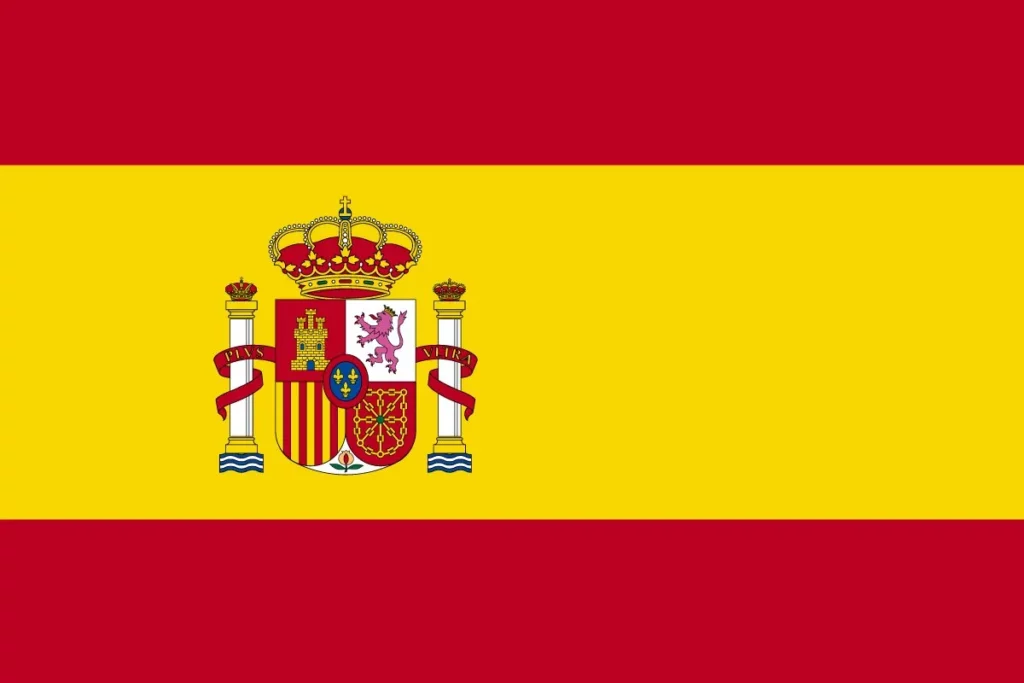
Raro ejemplo de fuente vertical con cuatro pilas superpuestas y un nicho superior que contiene una estatua de la Ninfa, diseñada por Orazio Nigrone (1615). Orgullo y alegría de los habitantes de Castelvetrano, conmemora la finalización del acueducto Bigini, un gran logro para el abastecimiento de agua de la ciudad. En él se reproduce varias veces la palmera, símbolo de la familia Tagliavia. En la actualidad, la palmera es el emblema de la ciudad, junto con la leyenda Palmosa Civitas Castrum Veteranum, en clara alusión a Selinunte, a la que se alude como Palmosa en el tercer canto de la Eneida.

مثال نادر على النافورة العمودية ذات الأحواض الأربعة المتراكبة والمشكاة العلوية التي تحتوي على تمثال للحورية، صممها أورازيو نيغروني (1615). تُعد هذه النافورة مصدر فخر وبهجة لسكان كاستيلفيترانو، وهي تخلد ذكرى اكتمال قناة بيجيني، وهو إنجاز عظيم لإمدادات المياه في المدينة. وفيه تتكرر شجرة النخيل، رمز عائلة تاغليافيا، عدة مرات. واليوم، أصبحت النخلة شعار المدينة، إلى جانب أسطورة بالموزا سيفيتاس كاستروم فيترانوم، مع إشارة واضحة إلى سيلينونتي المشار إليها باسم بالموزا في الكانتو الثالث من آينيد.

这是一座罕见的立式喷泉,有四个叠置的水池和一个上部有仙女雕像的壁龛,由奥拉奇奥-尼格罗内(Orazio Nigrone,1615 年)设计。它是卡斯特尔维特拉诺人的骄傲和喜悦,是为了纪念比吉尼引水渠的竣工,这也是该镇供水的一大成就。塔利亚维亚家族的象征–棕榈树在其中多次重现。如今,棕榈树与 Palmosa Civitas Castrum Veteranum 的传说一起成为了这座城市的徽章,这显然与《埃涅伊德》第三章中将塞利南特称为 Palmosa 的典故有关。
Chiesa del Purgatorio
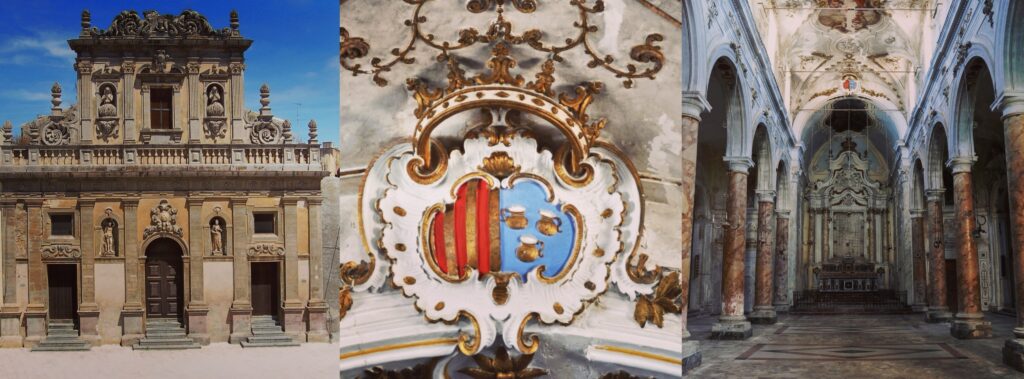
Eretta tra il 1642 ed il 1664 nel sito di una preesistente chiesa, ha una scenografica facciata settecentesca con elementi tardo manieristici e barocchi che fa da elemento decorativo alla piazza. L’interno ha 3 navate divise da colonne, é riccamente decorato con stucchi e affreschi: la decorazione dell’abside è opera dei castelvetranesi Nicola e Gaspare Curti (1746). Ad Olivio Sozzi si attribuisce invece la grande tela destinata all’altare maggiore, raffigurante la Trinità, la Vergine e le Anime Sante del Purgatorio, ora trasferita nella Chiesa Madre.

Erected between 1642 and 1664 on the site of a pre-existing church, it has a dramatic 18th-century façade with late Mannerist and Baroque elements that serves as a decorative element in the square. The interior has three naves divided by columns and is richly decorated with stucco and frescoes: the decoration of the apse was the work of Nicola and Gaspare Curti from Castelvetrano (1746). The large canvas destined for the high altar, depicting the Trinity, the Virgin and the Holy Souls in Purgatory, now transferred to the Mother Church, is attributed to Olivio Sozzi.

Érigée entre 1642 et 1664 sur le site d’une église préexistante, elle présente une façade spectaculaire du XVIIIe siècle avec des éléments maniéristes et baroques tardifs, qui sert d’élément décoratif sur la place. L’intérieur comporte trois nefs divisées par des colonnes et est richement décoré de stucs et de fresques : la décoration de l’abside est l’œuvre de Nicola et Gaspare Curti de Castelvetrano (1746). La grande toile destinée au maître-autel, représentant la Trinité, la Vierge et les Saintes Âmes du Purgatoire, aujourd’hui transférée dans l’église mère, est attribuée à Olivio Sozzi.

Sie wurde zwischen 1642 und 1664 an der Stelle einer früheren Kirche errichtet und besitzt eine dramatische Fassade aus dem 18. Jahrhundert mit spätmanieristischen und barocken Elementen, die als dekoratives Element auf dem Platz dient. Das Innere besteht aus drei Schiffen, die durch Säulen geteilt sind, und ist reich mit Stuck und Fresken verziert: Die Dekoration der Apsis ist ein Werk von Nicola und Gaspare Curti aus Castelvetrano (1746). Das große Gemälde für den Hauptaltar, das die Dreifaltigkeit, die Jungfrau Maria und die Heiligen Seelen im Fegefeuer darstellt und jetzt in die Mutterkirche übertragen wurde, wird Olivio Sozzi zugeschrieben.
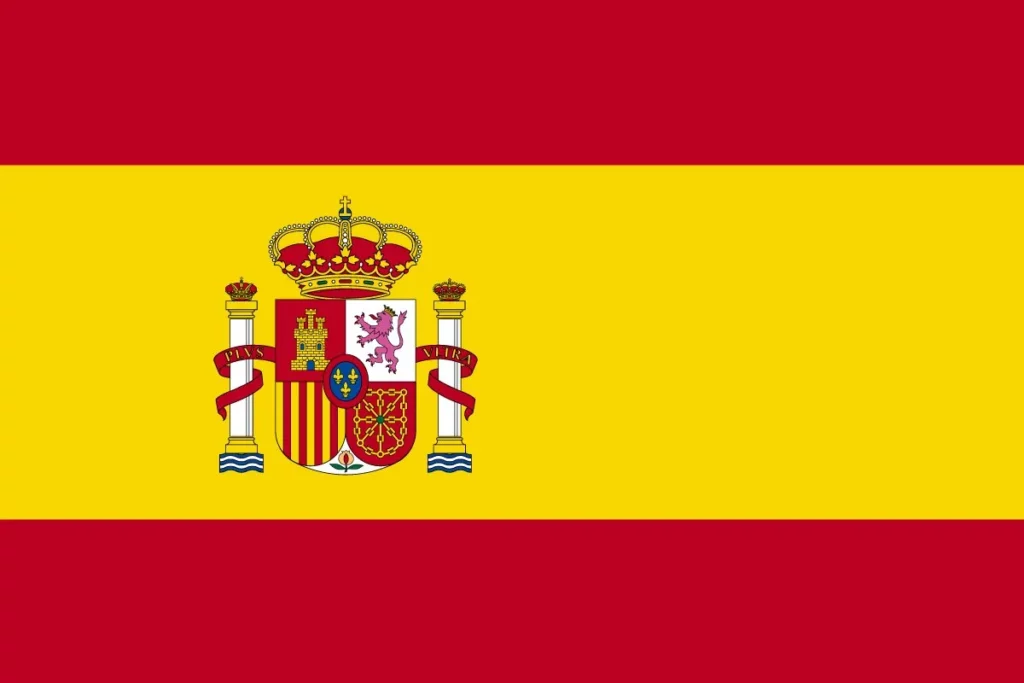
Erigida entre 1642 y 1664 en el emplazamiento de una iglesia preexistente, presenta una espectacular fachada del siglo XVIII con elementos manieristas y barrocos tardíos que sirve de elemento decorativo en la plaza. El interior tiene tres naves divididas por columnas y está ricamente decorado con estucos y frescos: la decoración del ábside es obra de Nicola y Gaspare Curti de Castelvetrano (1746). El gran lienzo destinado al altar mayor, que representa la Trinidad, la Virgen y las Santas Almas del Purgatorio, ahora trasladado a la Iglesia Madre, se atribuye a Olivio Sozzi.

تم تشييدها بين عامي 1642 و1664 في موقع كنيسة كانت موجودة من قبل، وتتميز بواجهة دراماتيكية تعود للقرن الثامن عشر مع عناصر من الطراز الباروكي والباروكي المتأخر، وهي بمثابة عنصر زخرفي في الساحة. يحتوي الجزء الداخلي على ثلاث بلاطات مقسمة بأعمدة ومزخرفة بزخارف غنية بالجص واللوحات الجدارية: زخرفة الحنية هي من عمل نيكولا وغاسباري كورتي من كاستيلفيترانو (1746). تُنسب اللوحة الكبيرة المخصصة للمذبح الرئيسي، التي تصور الثالوث والعذراء والأرواح المقدسة في المطهر، والتي نُقلت الآن إلى الكنيسة الأم، إلى أوليفيو سوتزي.

这座教堂于 1642 年至 1664 年间在原有教堂的基础上修建而成,其引人注目的 18 世纪外墙采用了晚期 Mannerist 风格和巴洛克风格的元素,成为广场上的一个装饰元素。教堂内部有三个中殿,由圆柱分隔,装饰有丰富的灰泥和壁画:天顶的装饰是卡斯特尔韦特拉诺的尼古拉-库尔蒂和加斯帕雷-库尔蒂的作品(1746 年)。高祭坛上的巨幅油画描绘的是三位一体、圣母和炼狱中的圣灵,现已移至母教堂,是奥利维奥-索齐(Olivio Sozzi)的作品。
Teatro Selinus
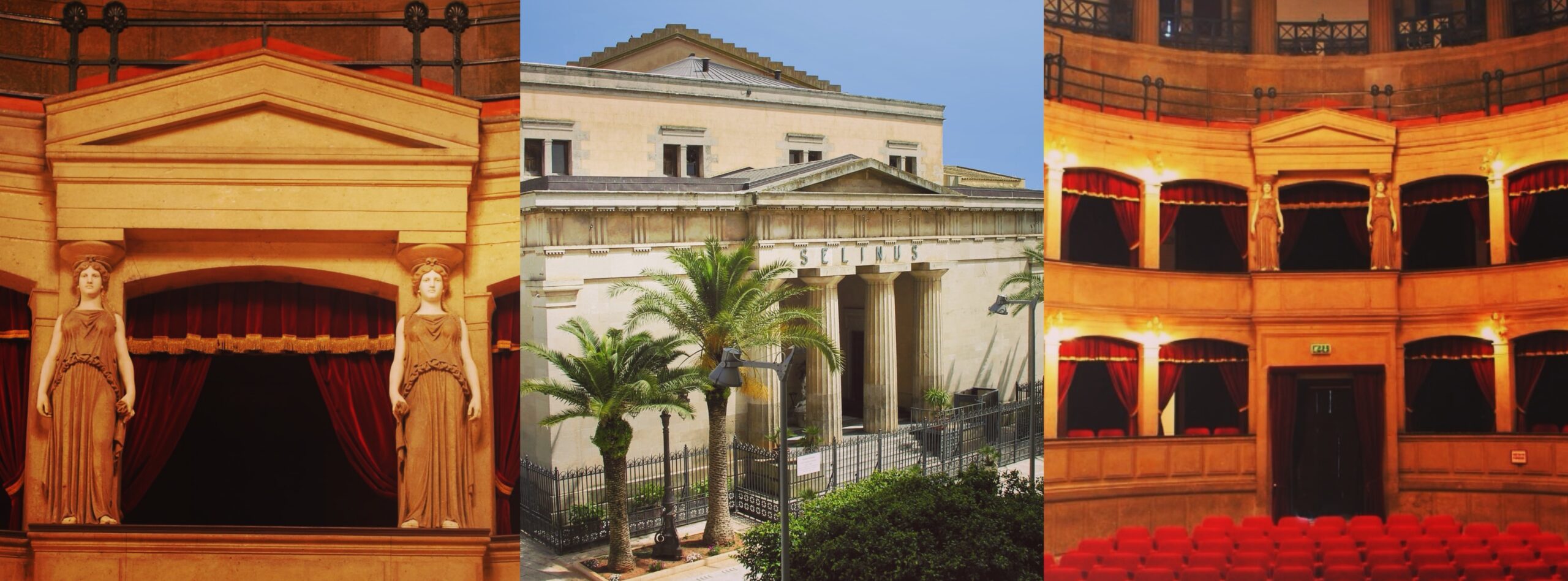
Il neoclassico Teatro della città ha una facciata che richiama i Templi di Selinunte con 4 colonne doriche, fregio con triglifi e timpano triangolare di coronamento, iniziato nel 1873, fu completato nel 1908 dall’architetto palermitano Giuseppe Patricolo. Al castelvetranese Gennaro Pardo si deve il dipinto del sipario, che rappresenta “L’Apoteosi di Empedocle a Selinunte” per la bonifica delle acque (1910). Interessante la decorazione del palco centrale con due sculture femminili, eseguite in pietra di “Billemi” dello scultore trapanese Leonardo Croce. Nell’atrio si apprezza la scultura della “Bambocciata” opera di Mario Rutelli. Il sito su cui sorge il teatro era anticamente occupato da un modesto albergo che nel 1787 ospitò il famoso scrittore Wolfgang Goethe.

The city’s neoclassical theatre has a façade reminiscent of the Temples of Selinunte with four Doric columns, a frieze with triglyphs and a triangular crowning tympanum. Beginning in 1873, it was completed in 1908 by the palermitan architect Giuseppe Patricolo. Gennaro Pardo is responsible for the painting of the curtain, depicting ‘The Apotheosis of Empedocles at Selinunte’ for the water reclamation (1910). The decoration of the central stage with two female sculptures in ‘Billemi’ stone by the trapanese sculptor Leonardo Croce is interesting. In the lobby, the sculpture of the ‘Bambocciata’ by Mario Rutelli can be appreciated. The site on which the theatre stands was formerly occupied by a modest hotel that hosted the famous writer Wolfgang Goethe in 1787.

Le théâtre néoclassique de la ville présente une façade qui rappelle les temples de Sélinonte avec quatre colonnes doriques, une frise avec des triglyphes et un tympan triangulaire. Commencé en 1873, il a été achevé en 1908 par l’architecte palermitain Giuseppe Patricolo. Le Castelvetrano Gennaro Pardo est responsable de la peinture du rideau représentant “L’Apothéose d’Empédocle à Sélinonte” pour la récupération des eaux (1910). La décoration de la scène centrale avec deux sculptures féminines en pierre “Billemi” du sculpteur trapanais Leonardo Croce est intéressante. Dans le hall, on peut apprécier la sculpture de la “Bambocciata” de Mario Rutelli. Le site sur lequel se trouve le théâtre était autrefois occupé par un modeste hôtel qui a accueilli le célèbre écrivain Wolfgang Goethe en 1787.

Das neoklassizistische Theater der Stadt hat eine Fassade, die an die Tempel von Selinunt erinnert, mit vier dorischen Säulen, einem Fries mit Triglyphen und einem dreieckigen, bekrönenden Tympanon. 1873 begonnen, wurde es 1908 vom Architekten Giuseppe Patricolo aus Palermo fertiggestellt. Der Castelvetrano Gennaro Pardo ist für die Bemalung des Vorhangs verantwortlich, der die “Apotheose des Empedokles in Selinunte” für die Wasseraufbereitung (1910) darstellt. Interessant ist die Dekoration der zentralen Bühne mit zwei weiblichen Skulpturen aus Billemi-Stein des trapanischen Bildhauers Leonardo Croce. Im Foyer kann man die Skulptur der “Bambocciata” von Mario Rutelli bewundern. An der Stelle, an der das Theater steht, befand sich früher ein bescheidenes Hotel, das 1787 den berühmten Schriftsteller Wolfgang Goethe beherbergte.
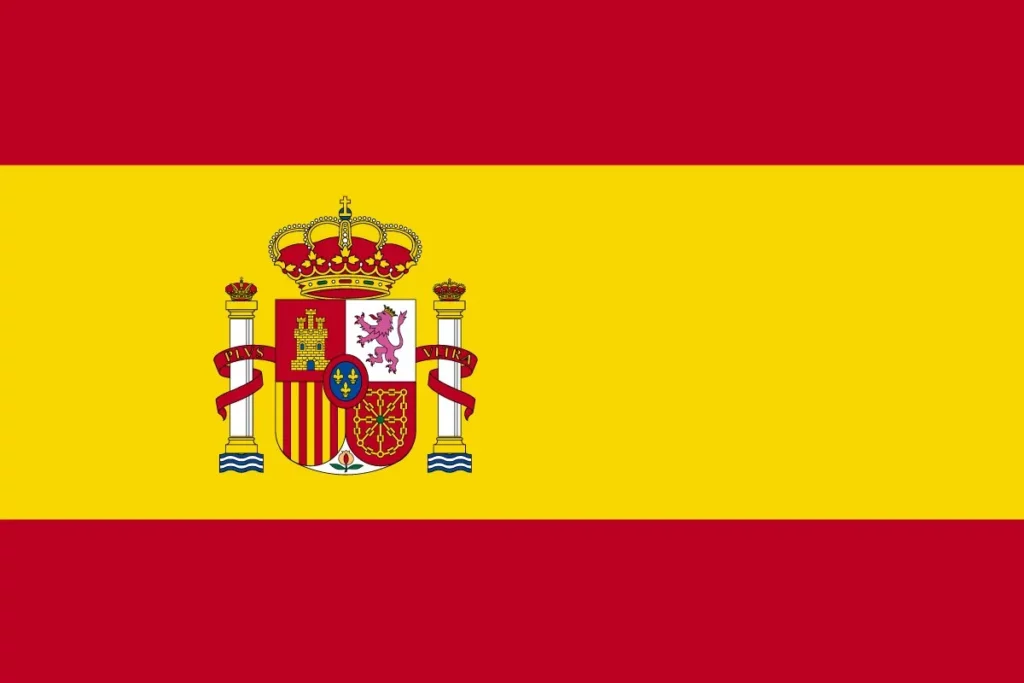
El teatro neoclásico de la ciudad tiene una fachada que recuerda a los templos de Selinunte, con cuatro columnas dóricas, un friso con triglifos y un tímpano triangular de coronación. Iniciado en 1873, fue terminado en 1908 por el arquitecto palermitano Giuseppe Patricolo. El castelvetrano Gennaro Pardo es el responsable de la pintura del telón, que representa “La Apoteosis de Empédocles en Selinunte” para la recuperación del agua (1910). Es interesante la decoración del escenario central con dos esculturas femeninas en piedra “Billemi” del escultor trapanés Leonardo Croce. En el vestíbulo se puede apreciar la escultura de la “Bambocciata” de Mario Rutelli. El solar sobre el que se levanta el teatro estaba ocupado antiguamente por un modesto hotel que alojó al célebre escritor Wolfgang Goethe en 1787.

يتميز المسرح الكلاسيكي الجديد في المدينة بواجهة تذكرنا بمعابد سيلينونتي مع أربعة أعمدة دوريك وإفريز به نقوش مثلثة وطبلية مثلثة الشكل. بدأ العمل فيه عام 1873، واكتمل في عام 1908 على يد المهندس المعماري باليرمو جوزيبي باتريكولو. كان المصمم المعماري جينارو باردو مسؤولاً عن رسم الستارة التي تصور “تأليه إمبيدوكليس في سيلينونتي” لاستصلاح المياه (1910). إن زخرفة المنصة المركزية بمنحوتتين نسائيتين من حجر “بيليمي” لنحات تراباني ليوناردو كروتشي مثيرة للاهتمام. في البهو، يمكن تقدير منحوتة “بامبوتشياتا” للنحات ماريو روتيلي. كان الموقع الذي يقوم عليه المسرح مشغولاً في السابق بفندق متواضع استضاف الكاتب الشهير فولفغانغ غوته عام 1787.

这座新古典主义剧院的外立面让人联想到塞利农特神庙,有四根多立克柱子,楣板上有三叉戟和三角形的顶盖。 该剧院始建于 1873 年,1908 年由巴勒莫建筑师朱塞佩-帕特里科洛建成。 卡斯特尔维特拉诺-根纳罗-帕尔多(Castelvetrano Gennaro Pardo)负责帷幕的绘画,描绘的是 “塞利农特的恩培多克勒神化”(The Apotheosis of Empedocles at Selinunte,1910 年)。舞台中央有两尊由特拉帕尼雕塑家莱昂纳多-克罗齐(Leonardo Croce)用 “比勒米 “石雕刻的女性雕塑,装饰十分有趣。在大厅里,可以欣赏到马里奥-鲁泰利(Mario Rutelli)创作的 “Bambocciata “雕塑。剧院所在地曾是一家简陋的旅馆,1787 年著名作家沃尔夫冈-歌德曾在此居住。
Museo Civico
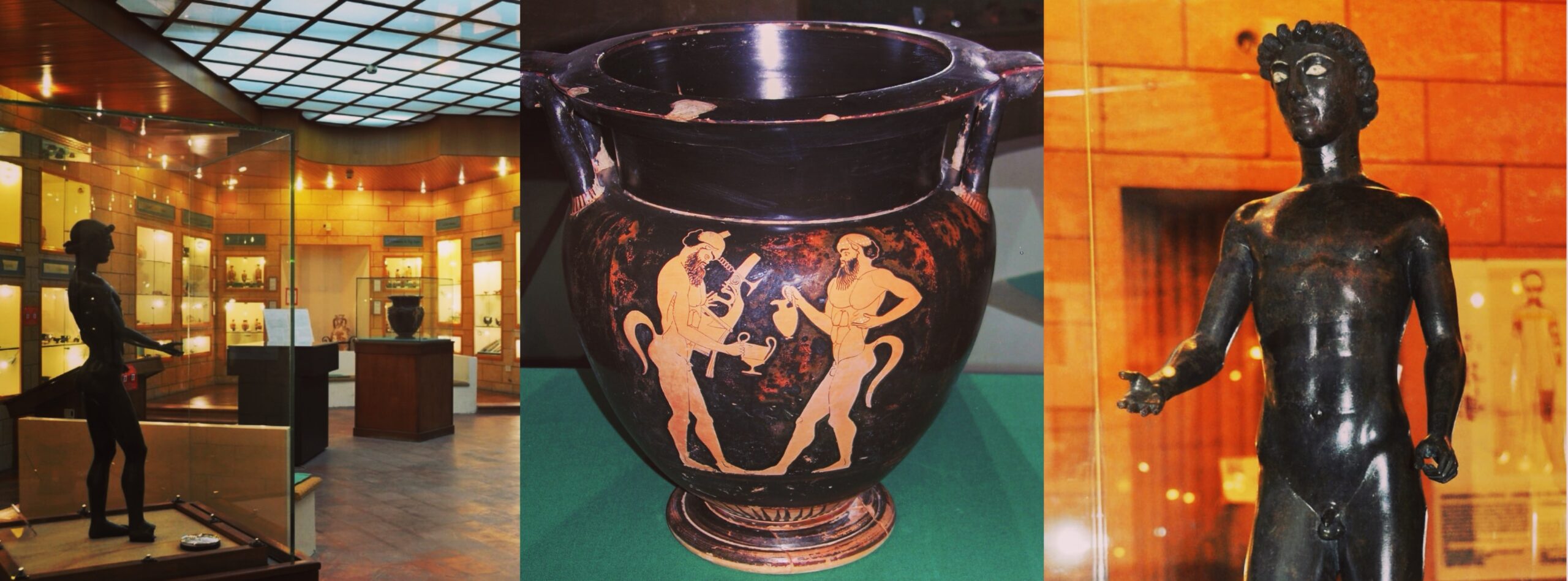
Il museo custodisce reperti di straordinario valore archeologico e storico-artistico. Vi trova degna sistemazione l’Efebo di Selinunte, uno dei ritrovamenti più importanti avvenuti nell’area archeologica, ed è uno dei pochissimi originali greci. Rientrò a Castelvetrano dopo il furto del 1962 e la successiva esposizione al museo archeologico di Palermo. É una statua bronzea alta 85 cm della prima metà del V sec. a. C. dai caratteri spiccatamente locali. Si possono inoltre ammirare: una ricca collezione di ceramica Attica e Corinzia, un mirabile cratere a figure rosse con Sileni, monete, bronzi e una stadera bizantina.

The museum houses findings of extraordinary archaeological and historical-artistic value. It houses the Efebo di Selinunte, one of the most important discoveries in the archaeological area, and one of the very few Greek originals. It was given back to Castelvetrano after its theft in 1962 and subsequent exhibition at the Archaeological Museum of Palermo. It is an 85 cm high bronze statue from the first half of the 5th century B. C. with distinctly local features. There is also a rich collection of Attic and Corinthian ceramics, an admirable red-figure krater with Sileni, coins, bronzes and a Byzantine stadia.

Le musée abrite des pièces d’une extraordinaire valeur archéologique et historico-artistique. Il abrite l’Efebo di Selinunte, l’une des découvertes les plus importantes de la zone archéologique et l’un des rares originaux grecs. Il est revenu à Castelvetrano après son vol en 1962 et son exposition au musée archéologique de Palerme. Il s’agit d’une statue en bronze de 85 cm de haut, datant de la première moitié du Ve siècle av. J.-C., avec des caractéristiques typiquement locales. Le musée abrite également une riche collection de céramiques attiques et corinthiennes, un admirable krater à figures rouges avec Sileni, des pièces de monnaie, des bronzes et une stadia byzantine.

Das Museum beherbergt Exponate von außerordentlichem archäologischem und kunsthistorischem Wert. Es beherbergt den Efebo von Selinunte, einen der wichtigsten Funde im archäologischen Gebiet und eines der wenigen griechischen Originale. Nach seinem Diebstahl im Jahr 1962 und der anschließenden Ausstellung im Archäologischen Museum von Palermo kehrte er nach Castelvetrano zurück. Es handelt sich um eine 85 cm hohe Bronzestatue aus der ersten Hälfte des 5. Jahrhunderts vor Christus. Jahrhunderts v. Chr. mit ausgeprägten lokalen Merkmalen. Außerdem gibt es eine reiche Sammlung attischer und korinthischer Keramik, einen bewundernswerten rotfigurigen Krater mit Sileni, Münzen, Bronzen und ein byzantinisches Stadion.
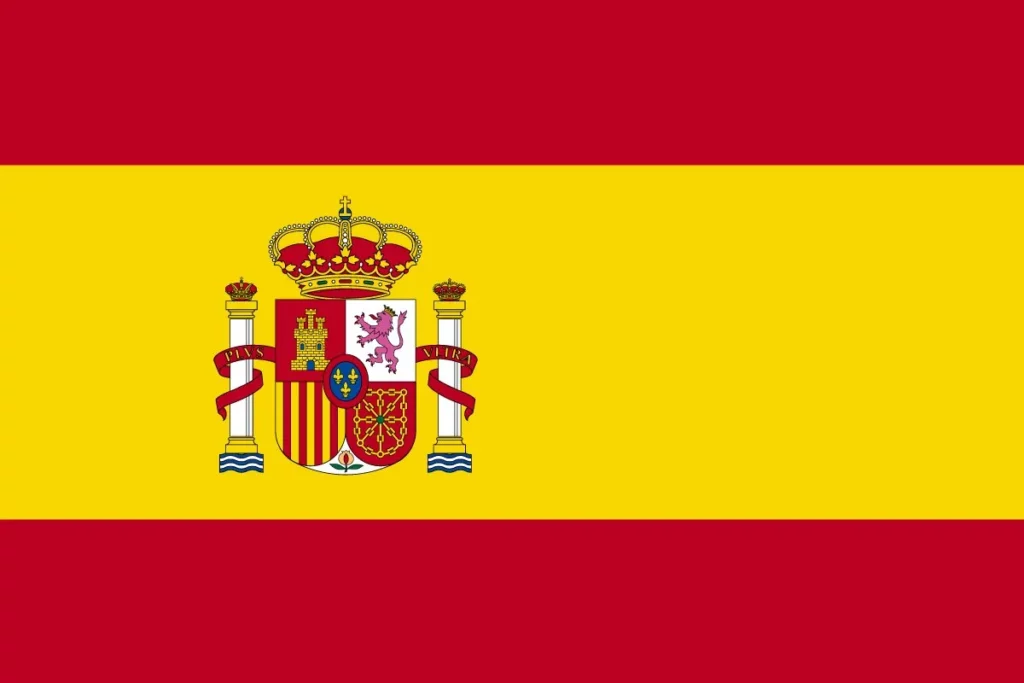
El museo alberga piezas de extraordinario valor arqueológico e histórico-artístico. Alberga el Efebo de Selinunte, uno de los hallazgos más importantes de la zona arqueológica y uno de los poquísimos originales griegos. Regresó a Castelvetrano tras su robo en 1962 y posterior exposición en el Museo Arqueológico de Palermo. Se trata de una estatua de bronce de 85 cm de altura de la primera mitad del siglo V a.C.. C. con rasgos claramente locales. También hay una rica colección de cerámicas áticas y corintias, una admirable crátera de figuras rojas con Sileni, monedas, bronces y una estadia bizantina.

يضم المتحف معروضات ذات قيمة أثرية وتاريخية فنية استثنائية. وهو يضم تمثال إفيبو دي سيلينونتي، وهو أحد أهم الاكتشافات في المنطقة الأثرية، وأحد القطع الأصلية اليونانية القليلة جداً. عاد إلى كاستيلفيترانو بعد سرقته في عام 1962 وعرضه لاحقاً في المتحف الأثري في باليرمو. وهو عبارة عن تمثال برونزي بارتفاع 85 سم من النصف الأول من القرن الخامس قبل الميلاد. م. بسمات محلية واضحة. هناك أيضاً مجموعة غنية من الخزف العلية والكورنثية، وتمثال رائع على شكل كراتر أحمر اللون مع سيليني وعملات معدنية وبرونزية ومقعد بيزنطي.

博物馆内的展品具有非凡的考古和历史艺术价值。馆内陈列着塞利农特的埃菲波(Efebo di Selinunte),这是该考古区最重要的发现之一,也是为数不多的希腊原物之一。这座雕像在 1962 年被盗后回到了卡斯特尔维特拉诺,随后在巴勒莫考古博物馆展出。这是一座公元前 5 世纪上半叶的青铜雕像,高 85 厘米。这是一尊公元前 5 世纪上半叶的青铜雕像,高 85 厘米,具有明显的地方特色。此外,这里还收藏了丰富的阿提卡和科林斯时期的陶瓷器、一个令人惊叹的带有 Sileni 的红色雕像 krater、钱币、青铜器和一个拜占庭时期的 Stadia。
Chiesa di San Giovanni
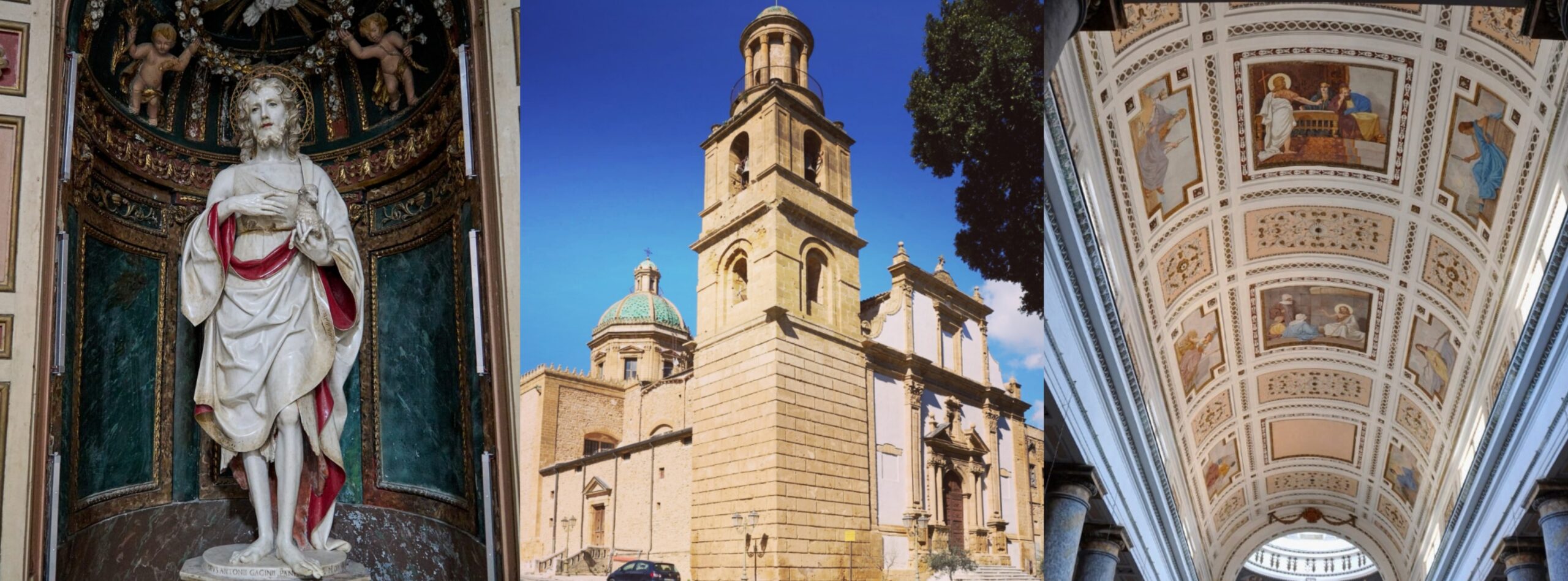
Eretta tra la fine del ‘500 e gli inizi del ‘600, subì radicali trasformazioni e modifiche tra il XVIII e XIX, tra cui la sostituzione della preesistente cupola con l’attuale. Custodisce notevoli opere d’arte, tra cui la statua marmorea di San Giovanni, patrono della città, firmata da Antonello Gagini (1522). Vi sono inoltre dipinti di Gherardo delle Notti, Pietro Novelli e Orazio Ferraro, e affreschi del castelvetranese Gennaro Pardo (1900-1901).

Built between the end of the 16th and the beginning of the 17th century, it underwent radical transformations and modifications between the 18th and 19th centuries, including the replacement of the existing dome with the current one.
It houses notable works of art, including the marble statue of St John, patron saint of the city, signed by Antonello Gagini (1522). There are also paintings by Gherardo delle Notti, Pietro Novelli and Orazio Ferraro, and frescoes by Castelvetrano Gennaro Pardo (1900-1901).

Érigée entre la fin du XVIe et le début du XVIIe siècle, elle a subi des transformations et des modifications radicales entre le XVIIIe et le XIXe siècle, notamment le remplacement de la coupole préexistante par la coupole actuelle. Elle abrite des œuvres d’art remarquables, dont la statue en marbre de Saint-Jean, le saint patron de la ville, signée par Antonello Gagini (1522). On y trouve également des peintures de Gherardo delle Notti, Pietro Novelli et Orazio Ferraro, ainsi que des fresques de Castelvetrano Gennaro Pardo (1900-1901).

Sie wurde zwischen dem späten 16. und dem frühen 17. Jahrhundert errichtet und zwischen dem 18. und dem 19. Jahrhundert radikal umgebaut und verändert, wobei die frühere Kuppel durch die heutige ersetzt wurde. Sie beherbergt bedeutende Kunstwerke, darunter die Marmorstatue des Heiligen Johannes, des Schutzpatrons der Stadt, die von Antonello Gagini (1522) signiert wurde. Außerdem gibt es Gemälde von Gherardo delle Notti, Pietro Novelli und Orazio Ferraro sowie Fresken von Castelvetrano Gennaro Pardo (1900-1901).
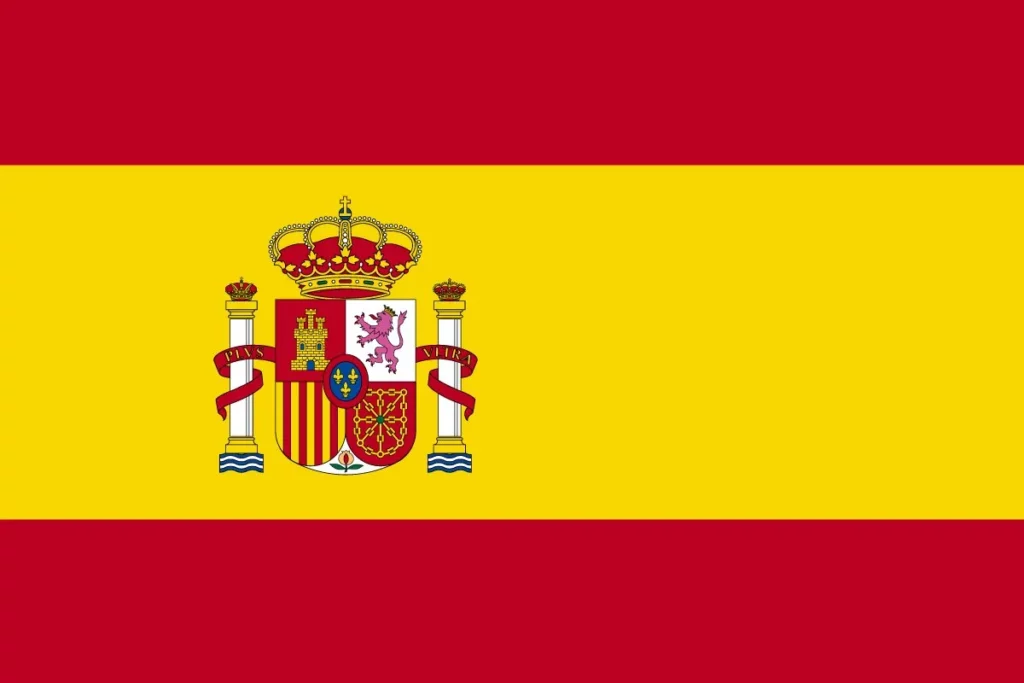
Erigida entre finales del siglo XVI y principios del XVII, sufrió transformaciones y modificaciones radicales entre los siglos XVIII y XIX, incluida la sustitución de la cúpula preexistente por la actual. Alberga notables obras de arte, como la estatua de mármol de San Juan, patrón de la ciudad, firmada por Antonello Gagini (1522). También hay pinturas de Gherardo delle Notti, Pietro Novelli y Orazio Ferraro, y frescos de Castelvetrano Gennaro Pardo (1900-1901).

تم تشييده في الفترة ما بين أواخر القرن السادس عشر وأوائل القرن السابع عشر، وخضع لتحولات وتعديلات جذرية بين القرنين الثامن عشر والتاسع عشر، بما في ذلك استبدال القبة الموجودة من قبل بالقبة الحالية. يضم أعمالاً فنية بارزة، بما في ذلك التمثال الرخامي للقديس يوحنا، شفيع المدينة، والذي يحمل توقيع أنتونيلو جاجيني (1522). كما توجد لوحات لغيراردو ديلي نوتي وبيترو نوفيلي وأورازيو فيرارو ولوحات جدارية لكاستيلفيترانو جينارو باردو (1900-1901).

它建于 16 世纪末 17 世纪初,在 18 世纪和 19 世纪之间经历了翻天覆地的变化和改建,包括用现在的穹顶取代了之前存在的穹顶。这里陈列着著名的艺术品,包括安东内罗-加吉尼(Antonello Gagini)署名的城市守护神圣约翰大理石雕像(1522 年)。此外还有 Gherardo delle Notti、Pietro Novelli 和 Orazio Ferraro 的绘画作品,以及 Castelvetrano Gennaro Pardo(1900-1901 年)的壁画。
Chiesa di San Domenico
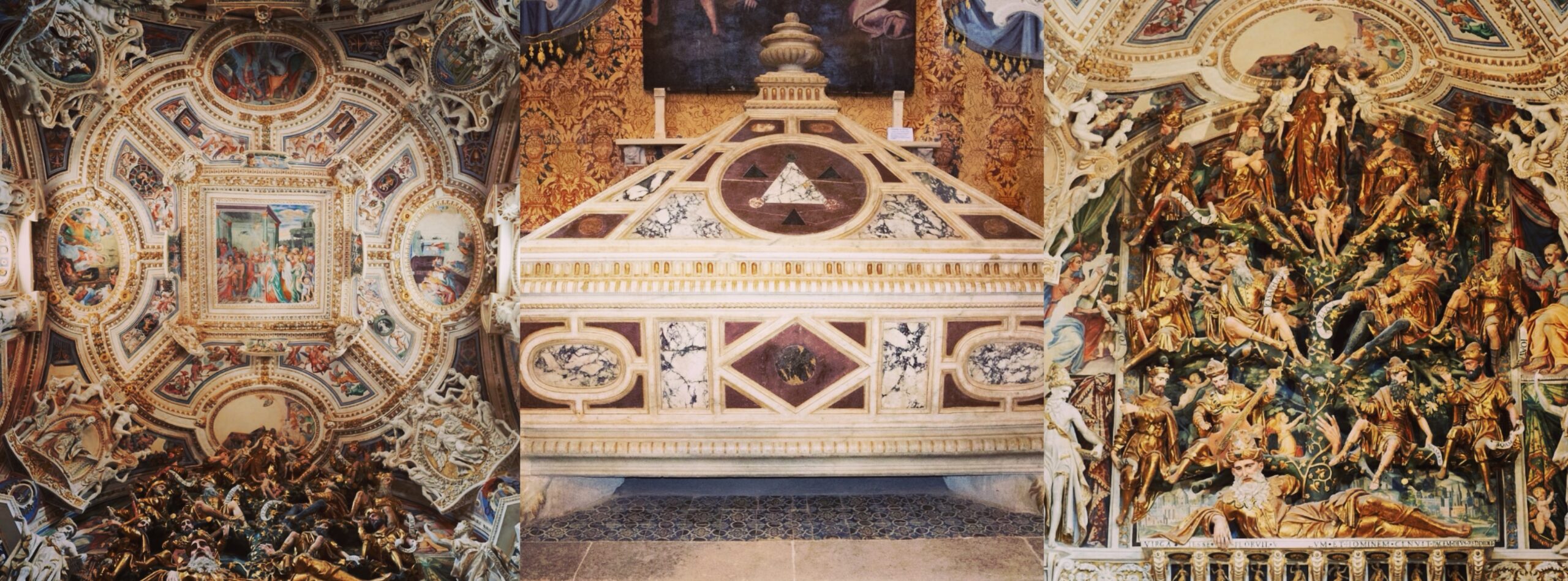
Foto di Gianni Polizzi
Voluta nel 1470 da Giovan Vincenzo Tagliavia, primo conte di Castelvetrano, fu completata nel 1580 da Don Carlo Aragona Tagliavia che la destinò a luogo di sepoltura della famiglia. Ad un esterno spoglio e austero, si contrappone un interno sorprendentemente ricco, con presbiterio e coro ornati da affreschi, altorilievi e statue in stucco celebranti l’avvento del Messia, opera del plasticatore e pittore manierista Antonio Ferraro da Giuliana che tra il 1574 e il 1580 sviluppò il tema in chiave quasi barocca. Rara e grandiosa è, inoltre, la rappresentazione plastica dell’albero di Jesse. La chiesa era annessa al convento dominicano (oggi sede del Liceo Classico G. Pantaleo). All’interno si conservano interessanti opere d’arte, come la pregevolissima Madonna di Loreto (1489), attribuita a Francesco Laurana, e una copia dello Spasimo di Raffaello (1574) di Giovanni Paolo Fondulli.

Commissioned in 1470 by Giovan Vincenzo Tagliavia, the first Count of Castelvetrano, it was completed in 1580 by Don Carlo Aragona Tagliavia, who designated it as the family burial place. A bare and austere exterior contrasts with a surprisingly rich interior, with presbytery and choir decorated with frescoes, high-reliefs and stucco statues celebrating the coming of the Messiah, the work of the Mannerist plasticist and painter Antonio Ferraro da Giuliana, who developed the theme in an almost Baroque key between 1574 and 1580. Rare and grandiose is also the plastic representation of the Tree of Jesse. The church was annexed to the Dominican convent (now home to the G. Pantaleo Classical High School). The interior houses interesting works of art, such as the very valuable Madonna di Loreto (1489), attributed to Francesco Laurana, and a copy of Raphael’s Spasimo (1574) by Giovanni Paolo Fondulli.

Commandée en 1470 par Giovan Vincenzo Tagliavia, premier comte de Castelvetrano, elle a été achevée en 1580 par Don Carlo Aragona Tagliavia, qui en a fait le lieu de sépulture de sa famille. L’extérieur dépouillé et austère contraste avec un intérieur étonnamment riche, avec un presbytère et un chœur décorés de fresques, de hauts-reliefs et de statues en stuc célébrant la venue du Messie, œuvre du plasticien et peintre maniériste Antonio Ferraro da Giuliana, qui a développé le thème dans une tonalité presque baroque entre 1574 et 1580. Rare et grandiose est également la représentation plastique de l’arbre de Jessé. L’église a été annexée au couvent dominicain (qui abrite aujourd’hui le lycée classique G. Pantaleo). L’intérieur abrite des œuvres d’art intéressantes, comme la très précieuse Madone de Lorette (1489), attribuée à Francesco Laurana, et une copie du Spasimo de Raphaël (1574) par Giovanni Paolo Fondulli.

Sie wurde 1470 von Giovan Vincenzo Tagliavia, dem ersten Grafen von Castelvetrano, in Auftrag gegeben und 1580 von Don Carlo Aragona Tagliavia vollendet, der sie als Familiengrabstätte bestimmte. Das kahle und nüchterne Äußere steht im Kontrast zu einem überraschend reichen Innenraum, in dem Presbyterium und Chor mit Fresken, Hochreliefs und Stuckstatuen geschmückt sind, die die Ankunft des Messias feiern, ein Werk des manieristischen Plastikers und Malers Antonio Ferraro da Giuliana, der das Thema zwischen 1574 und 1580 in einer fast barocken Tonart entwickelte. Selten und grandios ist auch die plastische Darstellung des Baums von Jesse. Die Kirche wurde an das Dominikanerkloster angebaut (heute Sitz des G. Pantaleo-Gymnasiums). Das Innere beherbergt interessante Kunstwerke, wie die sehr wertvolle Madonna di Loreto (1489), die Francesco Laurana zugeschrieben wird, und eine Kopie von Raffaels Spasimo (1574) von Giovanni Paolo Fondulli.
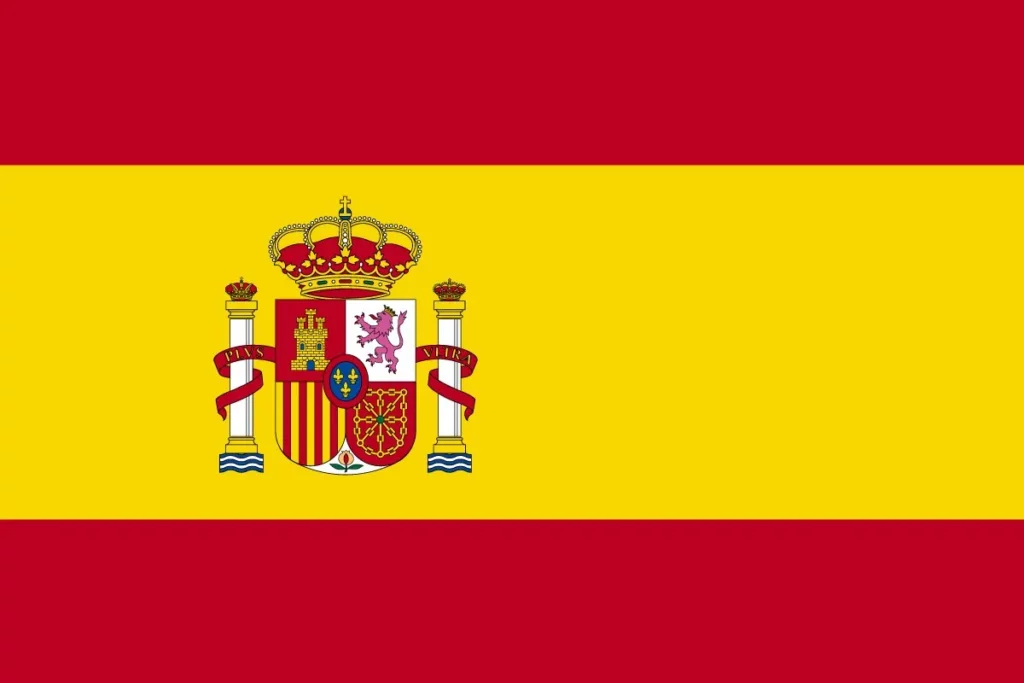
Encargada en 1470 por Giovan Vincenzo Tagliavia, primer conde de Castelvetrano, fue terminada en 1580 por Don Carlo Aragona Tagliavia, que la designó como lugar de enterramiento familiar. Un exterior desnudo y austero contrasta con un interior sorprendentemente rico, con presbiterio y coro decorados con frescos, altorrelieves y estatuas de estuco que celebran la venida del Mesías, obra del plasticista y pintor manierista Antonio Ferraro da Giuliana, que desarrolló el tema en clave casi barroca entre 1574 y 1580. Rara y grandiosa es también la representación plástica del Árbol de Jesé. La iglesia fue anexionada al convento dominico (hoy sede del Liceo Clásico G. Pantaleo). El interior alberga interesantes obras de arte, como la valiosísima Madonna di Loreto (1489), atribuida a Francesco Laurana, y una copia del Spasimo (1574) de Rafael realizada por Giovanni Paolo Fondulli.

تم تشييده عام 1470 بتكليف من جيوفان فينتشنزو تاغليافيا، أول كونت كاستيلفيترانو، وأكمله دون كارلو أراغونا تاغليافيا عام 1580، والذي خصصه ليكون مدفن العائلة. يتناقض المظهر الخارجي العاري والمتقشف مع التصميم الداخلي الغني بشكل مدهش، مع كاهن وجوقة مزينة بلوحات جدارية ونقوش بارزة وتماثيل جصية تحتفل بمجيء المسيح، وهي من أعمال التشكيلي والرسام التشكيلي المنير أنطونيو فيرارو دا جوليانا، الذي طور الموضوع بشكل باروكي تقريباً بين عامي 1574 و1580. ومن الأعمال النادرة والفخمة أيضاً التمثيل التشكيلي لشجرة يسى. ضُمت الكنيسة إلى الدير الدومينيكاني (الذي يضم الآن مدرسة جي بانتاليو الثانوية الكلاسيكية). يضم الجزء الداخلي أعمالاً فنية مثيرة للاهتمام، مثل لوحة مادونا دي لوريتو (1489) القيّمة جداً، والمنسوبة إلى فرانشيسكو لورانا ونسخة من لوحة سباسيمو لرافائيل (1574) لجيوفاني باولو فوندولي.

它于 1470 年由卡斯特尔维特拉诺的第一任伯爵乔万-文森佐-塔利亚维亚(Giovan Vincenzo Tagliavia)委托建造,1580 年由唐-卡罗-阿拉贡纳-塔利亚维亚(Don Carlo Aragona Tagliavia)完工,并被指定为家族墓地。光秃秃的朴素外观与令人惊讶的丰富内部形成鲜明对比,长廊和唱诗班装饰着壁画、高浮雕和灰泥雕像,颂扬弥赛亚的降临,这些都是 Mannerist 造型主义画家 Antonio Ferraro da Giuliana 的作品,他在 1574 年至 1580 年期间以近乎巴洛克的基调发展了这一主题。杰西之树的塑像也是罕见而宏伟的。教堂曾被并入多明我会修道院(现为 G. Pantaleo 古典中学所在地)。教堂内部陈列着一些有趣的艺术品,如非常珍贵的《洛雷托圣母像》(1489 年),据说是弗朗切斯科-劳拉纳(Francesco Laurana)所作,以及乔瓦尼-保罗-丰杜利(Giovanni Paolo Fondulli)临摹的拉斐尔的《斯帕西莫》(1574 年)。
Collegiata di San Pietro e Paolo
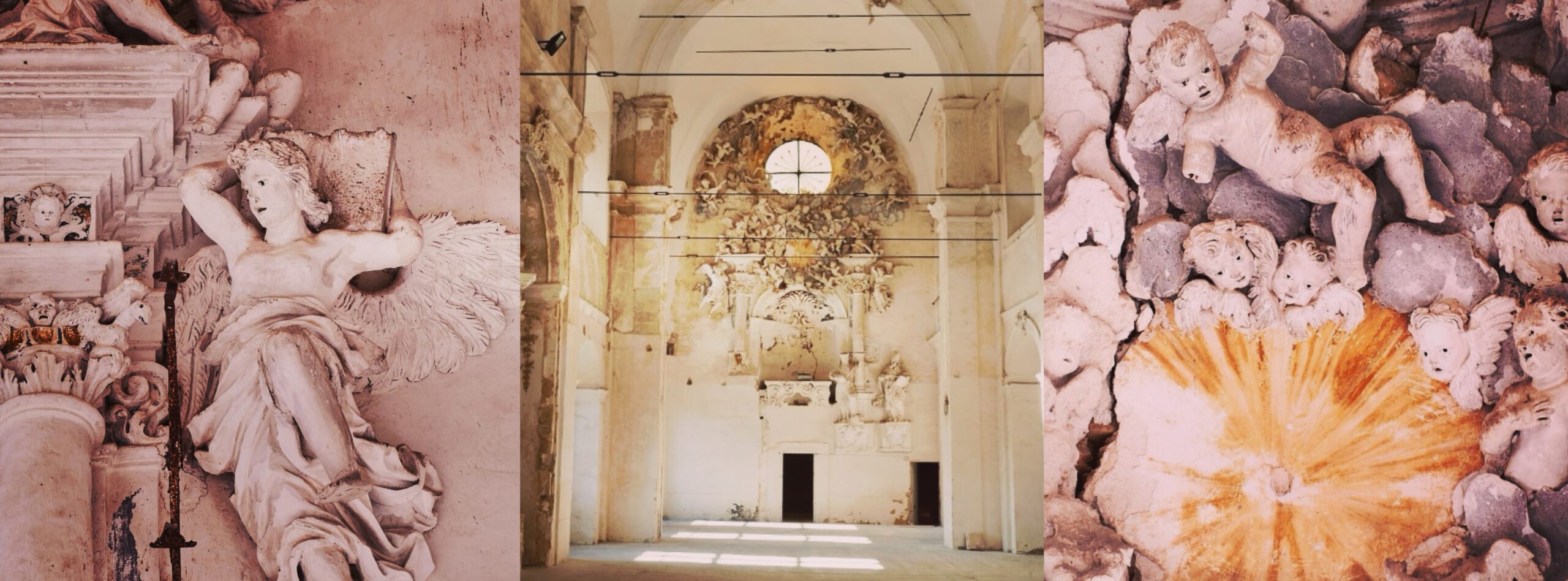
Nel 1653 dallo smantellamento della torre di Sud-Est del Castello, venne realizzata al piano nobile, in sostituzione di una più antica cappella palatina, la Collegiata di San Pietro e Paolo. Inaugurata nel 1657 da Don Diego Aragona Pignatelli e dalla figlia Giovanna Aragona Pignatelli Cortes, con chiara somiglianza alla Cappella Reale di Palermo. La facciata appare spoglia, priva com’era dell’imponente scalone che con una doppia rampa dava accesso all’edificio, al suo interno (dopo vari restauri) rivivono stucchi barocchi tipici della scuola del Serpotta. L’altare maggiore è caratterizzato da decori di putti festosi con evidenti riferimenti alla coeva Gloria del Bernini di San Pietro a Roma.

In 1653, from the dismantling of the south-east tower of the Castle, the Collegiata Church of St. Peter and St. Paul was built on the piano nobile, replacing an older palatine chapel. Inaugurated in 1657 by Don Diego Aragona Pignatelli and his daughter Giovanna Aragona Pignatelli Cortes, it bears a clear resemblance to the Royal Chapel in Palermo. The façade appears bare, deprived as it was of the imposing staircase that gave access to the building with a double ramp; inside (after various restorations), Baroque stuccoes typical of the Serpotta school are revived. The high altar is characterised by decorations of festive Putti with clear references to Bernini’s contemporary Glory of St. Peter’s in Rome.

En 1653, à partir du démantèlement de la tour sud-est du château, la collégiale Saint-Pierre et Saint-Paul a été construite au rez-de-chaussée pour remplacer une chapelle palatine plus ancienne. Inaugurée en 1657 par Don Diego Aragona Pignatelli et sa fille Giovanna Aragona Pignatelli Cortes, elle présente une nette ressemblance avec la chapelle royale de Palerme. La façade apparaît dépouillée, privée de l’imposant escalier qui permettait d’accéder à l’édifice par une double rampe ; à l’intérieur (après diverses restaurations), les stucs baroques typiques de l’école Serpotta sont ravivés. Le maître-autel est caractérisé par des décorations de putti festifs qui font clairement référence à la Gloire de Saint-Pierre de Rome, une œuvre contemporaine du Bernin.

1653 wurde nach dem Abriss des Südostturms des Schlosses die Stiftskirche S. Pietro e S. Paulo auf dem Piano Nobile errichtet, die eine ältere Palatinenkapelle ersetzte. Sie wurde 1657 von Don Diego Aragona Pignatelli und seiner Tochter Giovanna Aragona Pignatelli Cortes eingeweiht und weist eine deutliche Ähnlichkeit mit der Königlichen Kapelle in Palermo auf. Die Fassade erscheint kahl, da sie der imposanten Treppe beraubt wurde, die den Zugang zum Gebäude über eine doppelte Rampe ermöglichte; im Inneren werden (nach verschiedenen Restaurierungen) die für die Schule von Serpotta typischen barocken Stuckarbeiten wieder aufgenommen. Der Hauptaltar ist durch die Dekoration mit festlichen Putten gekennzeichnet, die deutliche Bezüge zu Berninis zeitgenössischer Glorie von St. Peter in Rom aufweisen.
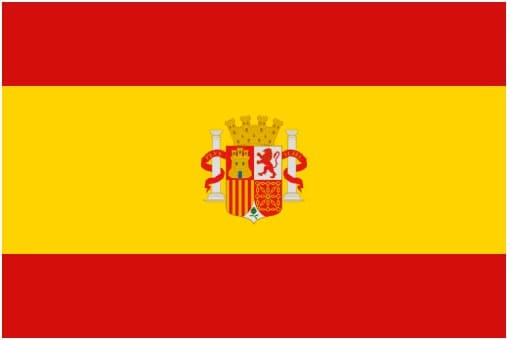
En 1653, a partir del desmantelamiento de la torre sureste del Castillo, se construyó en el piano nobile la Colegiata de San Pedro y San Pablo, en sustitución de una antigua capilla palatina. Inaugurada en 1657 por Don Diego Aragona Pignatelli y su hija Giovanna Aragona Pignatelli Cortes, presenta un claro parecido con la Capilla Real de Palermo. La fachada aparece desnuda, privada como estaba de la imponente escalinata que daba acceso al edificio con una doble rampa; en el interior (tras varias restauraciones), reviven los estucos barrocos típicos de la escuela Serpotta. El altar mayor se caracteriza por una decoración de putti festivos con claras referencias a la Gloria de San Pedro de Roma, contemporánea de Bernini.

في عام 1653، من تفكيك البرج الجنوبي الشرقي للقلعة، تم بناء كنيسة القديس بطرس والقديس بولس الجماعية على البيانو نوبيل، لتحل محل كنيسة قصر قديمة. افتتحها دون دييغو أراغونا بيجناتيلي وابنته جيوفانا أراغونا بيجناتيلي كورتيس عام 1657، وهي تشبه بشكل واضح الكنيسة الملكية في باليرمو. تبدو الواجهة عارية، محرومة من الدرج المهيب الذي كان يتيح الوصول إلى المبنى بمنحدر مزدوج؛ وفي الداخل (بعد عمليات الترميم المختلفة)، تم إحياء الجص الباروكي النموذجي لمدرسة سيربوتا. يتميز المذبح المرتفع بزخارف من المعجون الاحتفالي مع إشارات واضحة إلى لوحة مجد القديس بطرس المعاصرة لبرنيني في روما.

1653 年,在拆除城堡东南塔楼的基础上,在金色钢琴上修建了圣彼得和圣保罗主教堂,取代了旧的宫廷小教堂。这座教堂于 1657 年由唐-迭戈-阿拉贡纳-皮格纳泰利和他的女儿乔瓦娜-阿拉贡纳-皮格纳泰利-科尔特斯主持落成,与巴勒莫的皇家小教堂十分相似。教堂的正面光秃秃的,没有了气势恢宏的楼梯,而楼梯是通过双坡道进入教堂的;教堂内部(经过多次修复)恢复了塞尔波塔学派典型的巴洛克式灰泥装饰。高祭坛的特点是装饰着节日的莆蒂,明显参考了贝尔尼尼当代的罗马圣彼得大教堂。



